Patrick Smith ("Ask the Pilot") weighs in on Tuesday's A380-v.-Commuter Jet altercation at JFK:
The Airbus A380 is the largest commercial aircraft ever built (and the ugliest too, but that's another story). From the start, concerns over the plane's size have been about apron and taxiway space, not runway space. It requires no more runway for takeoff or landing than most other widebody jets, but presents serious challenges when it comes to maneuvering around terminals and along congested taxiways. It is only marginally longer or taller than the Boeing 747, but its wingspan is more than 60 feet wider. Many taxiways are off-limits, and A380 pilots need to be extra vigilant when operating at busy airports. The same goes for ATC ground controllers. With relatively few A380s in service, controllers are still getting familiar with their requirements.
Was the Air France crew on the correct assigned taxiway? Had they obeyed any requisite "hold short" instructions? Was the Comair plane stopped where it was supposed to be stopped? Did the controllers miss something?
One or more of those things is possible. But looking again at that video ... Regardless of who or what is to blame, perhaps the most important take-away is that old, in-one-ear-and-out-the-other dictum from the flight attendants: PLEASE REMAIN SEATED WITH YOUR SEAT BELT SECURELY FASTENED UNTIL THE SEAT BELT SIGN HAS BEEN TURNED OFF.
As an aside, I have a little dream, that someday, more nervous fliers will read Patrick Smith, and more nervous computer users will read Bruce Schneier. I think we'd have less panic in the US if that happened.
The New York Times reports on new data about how languages diversified:
A researcher analyzing the sounds in languages spoken around the world has detected an ancient signal that points to southern Africa as the place where modern human language originated.
The detection of such an ancient signal in language is surprising. Because words change so rapidly, many linguists think that languages cannot be traced very far back in time. The oldest language tree so far reconstructed, that of the Indo-European family, which includes English, goes back 9,000 years at most.
Quentin D. Atkinson, a biologist at the University of Auckland in New Zealand, has shattered this time barrier, if his claim is correct, by looking not at words but at phonemes — the consonants, vowels and tones that are the simplest elements of language. He has found a simple but striking pattern in some 500 languages spoken throughout the world: a language area uses fewer phonemes the farther that early humans had to travel from Africa to reach it.
I'd like to get more information about this; in particular, how does it account for languages like Basque that seem unrelated to their neighbors?
Back in my last term at Duke our technology strategy professor, Wes Cohen, assigned us two chapters from The Soul of a New Machine by Tracy Kidder. I'm reading the whole book now that I've got some time. Anyone who has the least interest in how teams work and where technology comes from should read it.
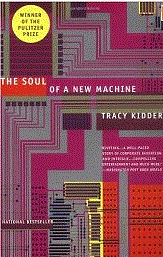 Kidder embedded himself in a team at the Data General corporation from early 1978 to late 1979 as they struggled to bring a 32-bit minicomputer to life. He describes borderline-Apergers engineers, 14-hour days, building motherboards from scratch, untested technologies, irresponsible schedules, burnout, and success—all around a computer that expressed the state of the art for perhaps six months after it came out. When Kidder wrote the book, in 1980, neither he nor any of the people he wrote about knew that minicomputers had become obsolete as a class already. None of them could see that IBM's toy computer, the PC, was about to make Data General irrelevant.
Kidder embedded himself in a team at the Data General corporation from early 1978 to late 1979 as they struggled to bring a 32-bit minicomputer to life. He describes borderline-Apergers engineers, 14-hour days, building motherboards from scratch, untested technologies, irresponsible schedules, burnout, and success—all around a computer that expressed the state of the art for perhaps six months after it came out. When Kidder wrote the book, in 1980, neither he nor any of the people he wrote about knew that minicomputers had become obsolete as a class already. None of them could see that IBM's toy computer, the PC, was about to make Data General irrelevant.
Kidder describes the team debugging prototype CPUs using oscilloscopes. He explains the near-impossibility of writing microcode—the instructions that tell a physical set of chips what to do and in what order—without using a second computer to write it on. He talks about engineers carrying around punchboard covered in blue and red wires, the red ones representing bug fixes, the blue representing the first attempt. You think it sucks figuring out which class broke the build in a modern C# development environment? Try imagining your joy at discovering that the CPU didn't work because a piece of solder came undone.
I imagine my reaction to this book might be similar to that of a modern nuclear submariner reading a contemporary account of building a state-of-the-art wooden battleship in 1862 (with only a brief mention of the Monitor and Merrimac, because almost no one understood in 1862 what those ships meant to naval combat). There are parts that made me wince, exactly as I winced in the episode of Mad Men when they showed an invitation to a wedding—to be held 22 November 1963.
About two years ago I read Pete Peterson's account of the heyday of WordPerfect Corp., which I also recommend, but for different reasons. Peterson wrote knowing the outcome, and he also had an axe to grind; but "Almost Perfect" still hits me right in the gut as a practicing software developer.
Twenty or thirty years from now, I'll look back and laugh at everything I didn't know in 2011. The Soul of a New Machine is a brilliantly-written monument to getting the job done, and advancing the profession right into a cul-de-sac.
On this day 150 years ago, the United States began its bloody civil war that left the South in ruins and 600,000 Americans dead. And on this day 50 years ago, Yuri Gagarin became the first human being to leave the planet and return safely.
But who, other than James Fallows, remembered that 10 years ago today, Microsoft strangled Clippy?
But what about Clippy? It's a big day for him too. Ten years ago, he was finally given the deep-six at Microsoft, or at least turned off by default as the first step to full elimination, so he would no longer automatically pop up with such helpful observations as, "It looks like you're writing a letter!" At Microsoft's Mix11 conference for web developers today in Las Vegas, Dean Hachamovitch, head of IE activities at Microsoft, announced the anniversary of Clippy's demise.
An Air France A380 collided with a commuter jet at JFK yesterday:
The tip of the left wing of the Air France Airbus 380 - the largest passenger plane made - bound for Paris hit the tail of a stationary Delta Comair Regional Jet 7 at 8:08 p.m., officials and witnesses said.
The Delta flight, which had just landed from Boston, was a connection to JFK for many London passengers. Those onboard exited onto the tarmac.
The NTSB press release reported no injuries among the 537 passengers and 29 crew members involved.
For several reasons—about 730 of them, really—I'm at Raleigh/Durham Airport for a couple of hours between London and Chicago. Yes, a direct flight to Chicago today would have cost $730 more. Someday, we'll discover that airline pricing schemes actually tap into the deepest secrets of the universe; for now, I'll just scratch my head and sit at RDU until 5pm.
On the way out to London, I got a photo of a phenomenon I've seen many times but never documented clearly. You know how the planet is more or less spherical? Here's some proof:

You can see this if you fly about 15 minutes past the terminator between night and day. The dark-blue wedge with the point on the left and the wide part under the wingtip is the earth's shadow.
I spent an unremarkable afternoon wandering an unremarkable suburb of London. Oh, Kew Gardens is pretty enough, and so was the weather, that I had a relaxing time, and I may even have avoided a major sunburn. The only remarkable thing about the walk was the Thames at low tide, which, even this far up, still ebbs and flows about 5 meters:
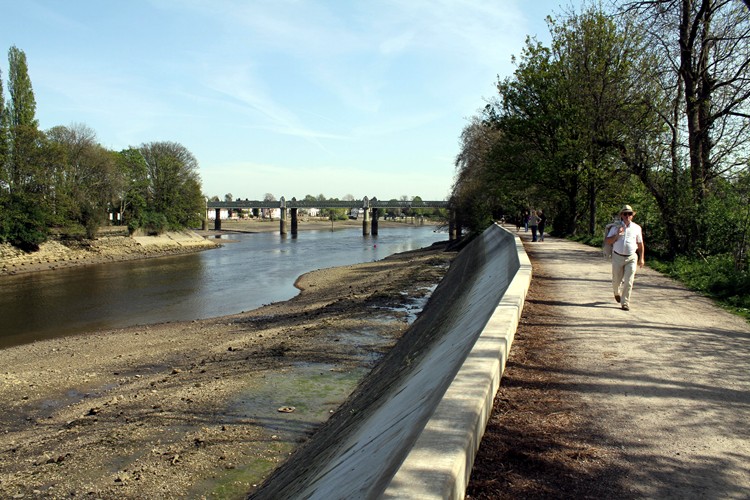
After the walk, I sat outside with a book and a beer. Sadly I did not have a dog, though the folks at the next table did, so all was not lost.
I met one of my oldest surviving friends in York this afternoon, thanks to the fast and cheap railways they've got in the UK. It's one thing to stay in a hotel built before my home town was founded; it's quite another to walk along a wall built over a thousand years before that.
First obligatory photo: York Minster, which opened as a small wooden church in 627 CE, and achieved this form somewhere around 800 years ago:

We also took advantage of an open house hosted by the York Glaziers Trust, who work to restore the stained glass at the Minster. I snapped this before seeing the "no photographs" sign:
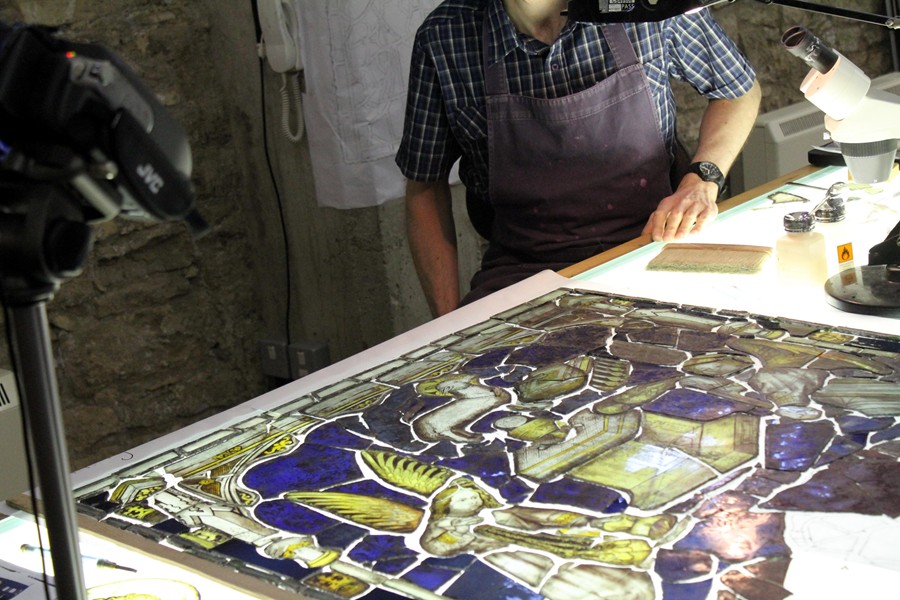
That's one panel of the 120 or so that make up the east wall of the Minster. John Thornton installed the windows about ten years before Columbus got lost in the Atlantic, or about 300 years before my country came into being. My friend and I both wondered if they'd ever dropped a piece of 15th-century glass, but we were both too chicken to ask the conservationists.
Getting out of York required jumping forward to the last few years, when York restored its Victorian-era railway station:

I've got one more day in the Land of Uk, so tomorrow look for some nighttime shots.
(About this post's title: for some reason I keep hearing the Swedish Chef in my head.)
I've walked on the Queen's Walk along the Thames about a half-dozen times, but on a day like today, I just had to do it again. This time, though, I had the beast with me, so I could do this:
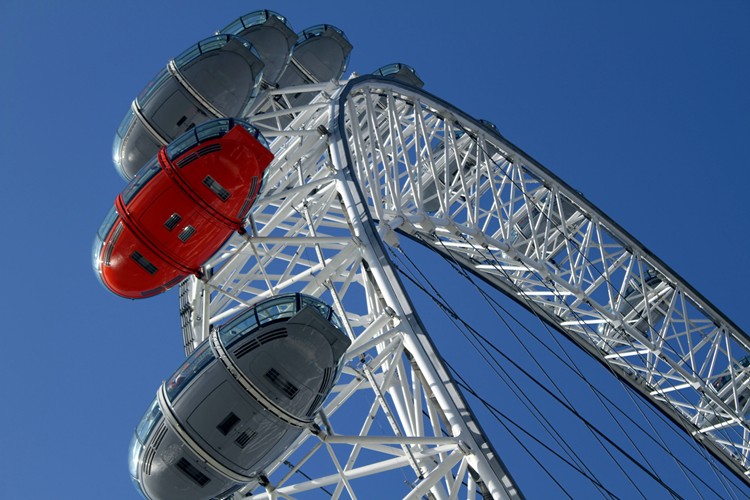
And this:
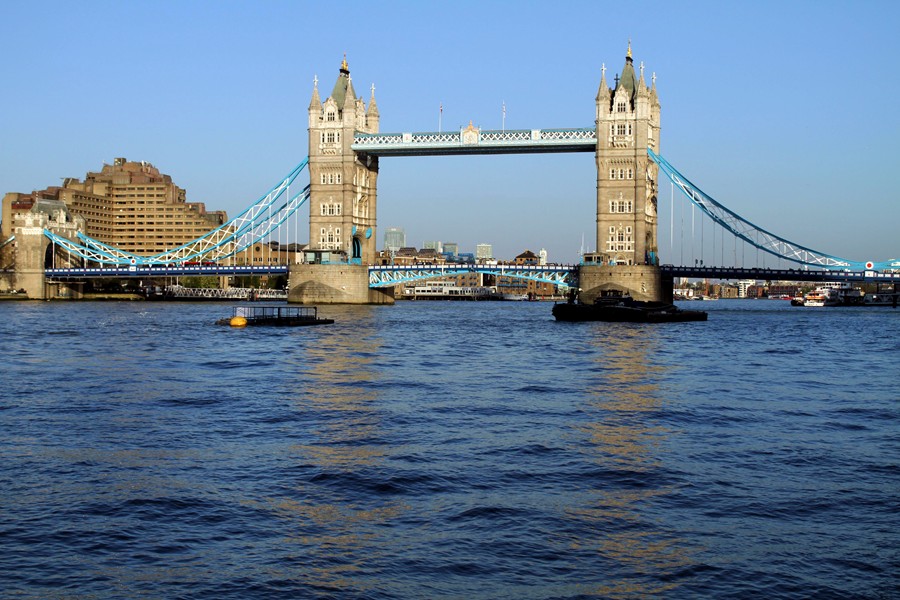
When I last photographed Tower Bridge on a sunny day, the painting crews hadn't finished yet. Today it looked perfect.